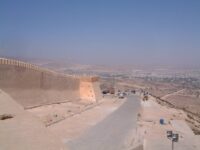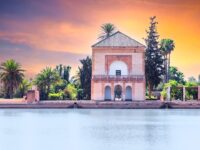History of Fez

Fez or Fez ([fās], in Arabic, Fes in English) is the third largest city in Morocco, after Casablanca and Rabat, with a population of 1 million (the Fassis). It is one of the four “imperial cities” (along with Marrakech, Meknes and Rabat). It is often considered the spiritual center of Morocco.
The old city, a model example of an oriental city, is under the protection of UNESCO. The deep blue of its ceramics is one of the characteristic symbols of Fez.
According to a legend, the name of the city comes from the discovery of a pickaxe at the site of the first foundations.
Fez is a religious, cultural and commercial center. The city is famous for its mosque, the Kairaouine, which was the largest in Africa until the new mosque in Casablanca was completed.
The economy of Fez still has many traditional industries: textile and flour factories, oil processing, tanneries, soap factories and crafts of all kinds. The region surrounding Fez produces cereals, beans, olives and grapes. Sheep, goat and cattle breeding is also practiced in the region.
Fez is strongly dominated by the old centers, while the modern centers serve as suburbs to the two old cities. Fez gave its name to the red, cylindrical hat used in most of the Muslim world.
Foundation
The city “Medinat Fas” was founded by Idris I in 789 in the place of the current Andalusian quarter. In 809, Idris II founded “al-Aliya” on the other bank of the wadi of Fez. Al Aliya developed very quickly and became a real city with mosque, palace and kisariya (market hall).
The vital water sources in the vicinity of Fez, which were known and praised in song even before its foundation, were undoubtedly an important criterion in the choice of the location for the future metropolis.
The following developments are due to two successive waves of emigration: from 817-818, about 800 Andalusian families expelled by the Umayyads from the Spanish city of Cordoba settled in the city founded by Idris I. Shortly after, about 2000 families banished from Kairouan settled on the other bank. The university mosque “Al-Qarawiyine” founded in the 9th century became one of the most important spiritual and cultural centers of Islam. Its influence is felt in the schools of Islamic Spain and beyond to Europe.
The newcomers brought with them both technical and artisanal know-how and a long experience of city life. Under their impetus, Fez became an important cultural center and after the foundation of the Qairawin University Mosque the religious heart of Morocco.
Fez is located in a particularly advantageous position, at the crossroads of important trade routes, in the heart of a naturally generous region with precious raw materials for crafts (stone, wood, clay). This allowed it to develop very quickly. Fez was on the caravan route from the Mediterranean to Black Africa via the great trading city Sidjilmassa (disappeared in the 17th century) in the region of Tafilalt (which nowadays corresponds to the region of Rissani/Erfoud).
Middle Ages
The two parts of the city unite in the Middle Ages, destroying the wall that separated them. Fez lost its role as capital with the Almohad foundation of Marrakech in the 11th century but regained it in 1250 thanks to the Marinid dynasty. Under their reign, the new city El Medinet El-Beida (the white city) was founded in 1276, it was equipped with ramparts, palaces and gardens. It was soon known as Fez Djedid (the new Fez) in opposition to Fez el Bali (the old city). The Jewish population around the palace was forced to leave and the mellah (ghetto in which the Jews lived under the protection of the sultan) was formed in the former garrison area of the Syrian archers. At the beginning of the 14th century (apogee of the Hispano-Moorish art), the city experienced a strong growth. The University of Fez was then known worldwide. Thanks to the caravans going to the port of Badis in the Rif, Fez was permanently linked to Islamic Spain and Europe. In 1471, the city fell to the Beni Wattas dynasty.
XVI-XVIIIth century
In 1522, Fez suffered an earthquake that partially destroyed the city. In the following years, many buildings were rebuilt, restored or replaced by new ones. The Saadi dynasty took the city in 1554 but chose Marrakech as its capital. At the end of the 17th century, with the beginning of the Alawite dynasty, Moulay Ismail chose Meknes as his new capital. He installed in Fez part of the Udaia clan that had helped him gain power. After his death (1727), the Udaia revolted, and were only driven out of the city in 1833 by Abd er Rahman. Moulay Abdallah, Moulay Ismail’s successor, made Fez his residence and renovated or newly built mosques, schools (madrasas), bridges and streets. The streets of Fez Djedid were paved.
19th century
In the 19th century, the two old parts of the city were connected with new constructions like the Boujloud Palace. Until the beginning of the protectorate in 1912, Fez was the capital of Morocco.
The French protectorate and independence
Rabat was officially declared the capital of Morocco, but Fez remained an important royal residence and a cultural, artisanal and commercial center. Under the direction of Lyautey and according to the plans of the architect Henri Prost, a new city was developed in the vicinity of Dar Debibagh, south of Fez Djedid. Although it was initially a residential area for Europeans, the “new city” continued to develop as a modern Arab city with new neighborhoods of villas. Authorities, institutions and service companies settled there.
Today, the city is home to
The city currently has about 1,400,000 inhabitants. Today the city of Fez has two parts: Fez Medina considered as a UNESCO World Heritage Site and Fez new city (Dar Dbibegh) which reflects the modernization and economic development of the country. Thus, it is in this part of Fez that modernity (shopping malls, buildings, 5-star hotels …) and culture meet. In recent decades, tourism has continued to develop (1 million visitors per year) and has become an important economic factor. This has become even more important thanks to cultural events such as the annual Festival of World Sacred Music in June.






